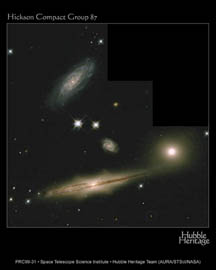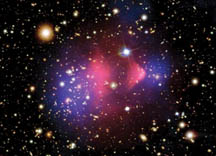
Dark Matter: The biggest building block of the universe
As a rule, scientists seek certainty. So it's rather unusual that for
more than 70 years, many astronomers have taken bets that the universe
is primarily made of dark matter, which is a mysterious and unproven
substance.
It's a bet that finally paid off, because a team of scientists
working with NASA's Chandra X-ray Observatory have found direct evidence
that dark matter is as real as the rings around Saturn. The discovery
states dark matter's status as the biggest building block in the
universe, while also putting to rest the nagging worries of many
astronomers that they gambled wrong.

Dark matter's gloomy nature has always rested uneasily with
astronomers. One of the main arguments for the existence of dark matter
involves galaxies and their clusters. Galaxies whisk (move) through
space at enormous speeds and are burning with hot clouds of gas. Speed
and heat of galaxies should cause them to fly apart, but they don't.
A leading explanation for this is that the gas and stars are held
together by the gravity of dark matter. Belief in dark matter is
widespread across the scientific community, but astronomers don't know
what it's made of. Still, they believe it acts like it has mass and
exerts gravity, yet is invisible and can't bump, touch or crash into
anything.
Like determining the origin of the universe or how black holes work,
dark matter is one of the important, but unexplained areas of astronomy.
Astronomers with Chandra, the Hubble Space Telescope, the European
Southern Observatory's Very Large Telescope, and the Magellan telescopes
all set their sights on a galaxy cluster nicknamed the 'Bullet Cluster'.
The cluster was an exciting target because of its unique distribution
of gas clouds and stars and potential the possibility for harbouring
dark matter. The amount of matter, or 'mass', in a galaxy is made up
mostly of the gas that surrounds it. Stars, planets, moons, and other
objects count too, but a majority of the mass still comes from the hot,
glowing clouds of hydrogen and other gases.

When the Bullet Cluster's galaxies crossed and merged (combined)
together, their stars easily continued on their way unharmed. This may
seem a bit confusing, because the bright light of stars makes them
appear enormous and crowded together.
It would be easy to expect them to smash into each other during their
cosmic travel. But the truth is, stars are actually spaced widely apart
and pass harmlessly like ships on an ocean. The gas clouds from the
merging galaxies, however, found the going much tougher. As the clouds
ran together, the rubbing and bumping of their gas molecules (very small
particles) caused friction to develop.
The friction slowed the clouds down, while the stars they contained
kept right on moving. Before long, the galaxies slipped out of the gas
clouds and into clear space. With the galaxies in open space, Chandra
scientists found dark matter hiding. When the stars separated from the
clouds, they gave astronomers a lucky chance to estimate their total
mass and gravity without the hot gas. The astronomers used their
telescopes and various methods to measure the mass of the galaxies. Dark
matter revealed itself when the team tried a technique called
"gravitational lensing".
This neat trick was inspired by Albert Einstein's prediction that
stars and galaxies of high mass can bend light toward them from other
sources. The amount of extra light can be calculated and tells
astronomers about the size of the galaxy.
The scientists had already calculated the masses of the galaxies
using other measuring methods. Yet, the results from gravitational
lensing showed the galaxies are bending much more light toward
themselves than they should be able to. The astronomers knew something
was wrong.
An unseen force, substance, or object had escaped the clouds along
with the galaxies and was helping to bend more light. For the first time
in history, astronomers caught dark matter at work. There it is, bright
as starlight: dark matter matters, as a matter of fact.
****
Did you know ?
* To survive a landing on Mars, a spacecraft must have three zeroes
off its speed in only six minutes. NASA's twin Mars Exploration Rovers
will need both parachutes and rockets to slow down from about 19,000
kmph (12,000 mph) as they enter the Red Planet's atmosphere to less than
19 kmph (12 mph) before they reach the surface.
* Speed Voyager 2 is travelling away from our Sun. About 57,600 kmph?
* There are 153 known moons orbiting the planets in our solar system.
* There are 63 known moons orbiting Jupiter. It has more moons than
any other planet in our solar system.
* Three new planets have been discovered in our solar system since
the invention of the telescope about 400 years ago.
* The age of our solar system is 4,500,000,000, give or take a few
hundred million years.
* There is only one planet in our solar system with liquid water on
the surface. It's Earth, in case you were wondering.
* The 1000th Sun grazing comet has been discovered by SOHO.
(Source: European Space Agency)
|


